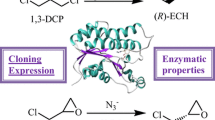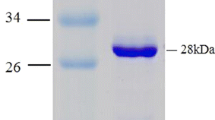Abstract
Elucidation of the molecular basis of the stability of enzymes from extremophilic organisms is of fundamental importance for various industrial applications. Due to the wealth of structural data from various species, dihydrofolate reductase (DHFR, EC 1.5.1.3) provides an excellent model for systematic investigations. In this report, DHFR from alkaliphilic Bacillus halodurans C-125 was cloned and expressed in E. coli. Functional analyses revealed that BhDHFR exhibits the most alkali-stable phenotype of DHFRs characterized so far. Optimal enzyme activity was observed in a slightly basic pH region ranging from 7.25 to 8.75. Alkali-stability is associated with a remarkable resistance to elevated temperatures (half-life of 60 min at 52.5°C) and to high concentrations of urea (up to 3 M). Although the secondary structure shows distinct similarities to those of mesophilic DHFR molecules, BhDHFR exhibits molecular features contributing to its alkaliphilic properties. Interestingly, the unique phenotype is diminished by C-terminal addition of a His-tag sequence. Therefore, His-tag-derivatized BhDHFR offers the opportunity to obtain deeper insights into the specific mechanisms of alkaliphilic adaption by comparison of the three dimensional structure of both BhDHFR molecules.





Similar content being viewed by others
Abbreviations
- DHFR:
-
Dihydrofolate reductase
- BhDHFR:
-
DHFR from Bacillus halodurans
- MTX:
-
Methotrexate
- DLS:
-
Dynamic light scattering
References
Andrade MA, Chacon P, Merlo JJ, Moran F (1993) Evaluation of secondary structure of proteins from UV circular dichroism spectra using an unsupervised learning neural network. Protein Eng 6:383–390
Appleman JR, Beard WA, Delcamp TJ, Prendergast NJ, Freisheim JH, Blakley RL (1990) Unusual transient- and steady-state kinetic behavior is predicted by the kinetic scheme operational for recombinant human dihydrofolate reductase. J Biol Chem 265:2740–2748
Baccanari DP, Averett D, Briggs C, Burchall J (1977) Escherichia coli dihydrofolate reductase: isolation and characterization of two isozymes. Biochemistry 16:3566–3572
Baccanari DP, Joyner SS (1981) Dihydrofolate reductase hysteresis and its effect of inhibitor binding analyses. Biochemistry 20:1710–1716
Dams T, Auerbach G, Bader G, Jacob U, Ploom T, Huber R, Jaenicke R (2000) The crystal structure of dihydrofolate reductase from Thermotoga maritima: molecular features of thermostability. J Mol Biol 297:659–672
Dann JG, Ostler G, Bjur RA, King RW, Scudder P, Turner PC, Roberts GC, Burgen AS (1976) Large-scale purification and characterization of dihydrofolate reductase from a MTXR strain of Lactobacillus casei. Biochem J 157:559–571
De Lemos Esteves F, Gouders T, Lamotte-Brasseur J, Rigali S, Frere JM (2005) Improving the alkalophilic performances of the Xyl1 xylanase from Streptomyces sp. S38: structural comparison and mutational analysis. Protein Sci 14:292–302
Delves CJ, Ballantine SP, Tansik RL, Baccanari DP, Stammers DK (1993) Refolding of recombinant Pneumocystis carinii dihydrofolate reductase and characterization of the enzyme. Protein Expr Purif 4:16–23
Demirjian DC, Moris-Varas FC, Cassidy S (2001) Enzymes from extremophiles. Curr Opin Chem Biol 5:144–151
Dubnovitsky AP, Kapetaniou EG, Papageorgiou AC (2005) Enzyme adaptation to alkaline pH: atomic resolution (1.08 A) structure of phosphoserine aminotransferase from Bacillus alcalophilus. Protein Sci 14:97–110
Elcock AH, McCammon JA (1998) Electrostatic contributions to the stability of halophilic proteins. J Mol Biol 280:731–748
Fan YX, Ju M, Zhou JM, Tsou CL (1996) Activation of chicken liver dihydrofolate reductase by urea and guanidine hydrochloride is accompanied by conformational change at the active site. Biochem J 315:97–102
Fierke CA, Johnson KA, Benkovic SJ (1987) Construction and evaluation of the kinetic scheme associated with dihydrofolate reductase from Escherichia coli. Biochemistry 26:4085–4092
Georgieva D, Koker M, Redecke L, Perbandt M, Clos J, Bredehorst R, Genov N, Betzel C (2004) Oligomerization of the proteolytic products in an intrinsic property of prion proteins. Biochem Biophys Res Commun 323:1278–1286
Hillcoat BL, Nixon PF, Blakley RL (1967) Effect of substrate decomposition on the spectrophotometric assay of dihydrofolate reductase. Anal Biochem 21:178–189
Honda Y, Kitaoka M (2004) A family 8 glycoside hydrolase from Bacillus halodurans C-125 (BH2105) is a reducing end xylose-releasing exo-oligoxylanase. J Biol Chem 279:55097–55103
Horikoshi K (1999) Alkaliphiles: some applications of their products for biotechnology. Microbiol Mol Biol Rev 63:735–750
Ikura Y, Horikoshi K (1979) Isolation and some properties of β-galactosidase-producing bacteria. Agric Biol Chem 43:85–88
Iwakura M, Tanaka T (1992) Dihydrofolate reductase from Bacillus subtilis and its artificial derivatives: expression, purification, and characterization. J Biochem (Tokyo) 111:638–642
Kalia A, Rattan A, Chopra P (1999) A method for extraction of high-quality and high-quantity genomic DNA generally applicable to pathogenic bacteria. Anal Biochem 275:1–5
Kaufman BT, Kemerer VF (1977) Characterization of chicken liver dihydrofolate reductase after purification by affinity chromatography and isoelectric focusing. Arch Biochem Biophys 179:420–431
Kraut J, Matthews DA (1987) Dihydrofolate reductase. In: Jurnak FA, McPherson A (eds) Biological macromolecules and assemblies: active sites of enzymes. Wiley, New York, pp 1–71
Ladenstein R, Antranikian G (1998) Proteins from hyperthermophiles: stability and enzymatic catalysis close to the boiling point of water. Adv Biochem Eng Biotechnol 61:37–85
Madern D, Ebel C, Zaccai G (2000) Halophilic adaptation of enzymes. Extremophiles 4:91–98
Maglia G, Masood H, Allemann RK (2003) Hydride transfer during catalysis by dihydrofolate reductase from Thermotoga maritima. Biochem J 374:529–535
McGuire JJ (2003) Anticancer antifolates: current status and future directions. Curr Pharm Des 9:2593–2613
Niehaus F, Bertoldo C, Kahler M, Antranikian G (1999) Extremophiles as a source of novel enzymes for industrial application. Appl Microbiol Biotechnol 51:711–729
Nielsen P, Fritze D, Priest FG (1995) Phenetic diversity of alkaliphilic Bacillus strains: proposal for nine new species. Microbiology 141:1745–1761
Pieper U, Kapadia G, Mevarech M, Herzberg O (1998) Structural features of halophilicity derived from the crystal structure of dihydrofolate reductase from the Dead Sea halophilic archaeon, Haloferax volcanii. Structure 6:75–88
Sambrook J, Frisch EF, Maniatis T (1989) Molecular cloning: a laboratory manual, 2nd edn. Cold Spring Harbor Laboratory Press, Cold Spring Harbor
Schweitzer BI, Dicker AP, Bertino JR (2000) Dihydrofolate reductase as a therapeutic target. FASEB J 4:2441–2452
Shirai T, Ishida H, Noda J, Yamane T, Ozaki K, Hakamada Y, Ito S (2001) Crystal structure of alkaline cellulase K: insight into the alkaline adaption of an industrial enzyme. J Mol Biol 310:1079–1087
Smith PK, Krohn RI, Hermanson GT, Mallia AK, Gartner FH, Provenzano MD, Fujimoto EK, Goeke NM, Olson BJ, Klenk DC (1985) Measurement of protein using bicinchoninic acid. Anal Biochem 150:76–85
Takami H, Nakasone K, Takaki Y, Maeno G, Sasaki R, Masui N, Fuji F, Hirama C, Nakamura Y, Ogasawara N, Kuhara S, Horikoshi K (2000) Complete genome sequence of the alkaliphilic bacterium Bacillus halodurans and genome sequence comparison with Bacillus subtilis. Nucl Acids Res 28:4317–4331
Then RL (2004) Antimicrobial dihydrofolate reductase inhibitors—achievements and future options. J Chemother 16:3–12
Thillet J, Adams JA, Benkovic SJ (1990) The kinetic mechanism of wild-type and mutant mouse dihydrofolate reductases. Biochemistry 29:5195–5202
Trujillo M, Donald RG, Roos DS, Greene PJ, Santi DV (1996) Heterologous expression and characterization of the bifunctional dihydrofolate reductase-thymidylate synthase enzyme of Toxoplasma gondii. Biochemistry 35:6366–6374
Vieille C, Zeikus GJ (2001) Hyperthermophilic enzymes: sources, uses, and molecular mechanisms for thermostability. Microbiol Mol Biol Rev 65:1–43
Vogt G, Woell S, Argos P (1997) Protein thermal stability, hydrogen bonds, and ion pairs. J Mol Biol 269:631–643
Volz KW, Matthews DA, Alden RA, Freer ST, Hansch C, Kaufman BT, Kraut J (1982) Crystal structure of avian dihydrofolate reductase containing phenyltriazine and NADPH. J Biol Chem 257:2528–3256
Wiegel J (1989) Anaerobic alkalithermophiles, a novel group of extremophiles. Extremophiles 2:257–267
Wilquet V, Gaspar JA, Van de Lande M, Van de Casteele M, Legrain C, Meiering EM, Glansdorff N (1998) Purification and characterization of recombinant Thermotoga maritima dihydrofolate reductase. Eur J Biochem 255:628–637
Acknowledgments
We are grateful to Hannah Schröder-Borm for excellent technical assistance.
Author information
Authors and Affiliations
Corresponding author
Additional information
Communicated by K. Horikoshi
Rights and permissions
About this article
Cite this article
Redecke, L., Brehm, M.A. & Bredehorst, R. Cloning and characterization of dihydrofolate reductase from a facultative alkaliphilic and halotolerant bacillus strain. Extremophiles 11, 75–83 (2007). https://doi.org/10.1007/s00792-006-0013-6
Received:
Accepted:
Published:
Issue Date:
DOI: https://doi.org/10.1007/s00792-006-0013-6




